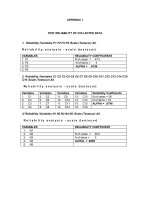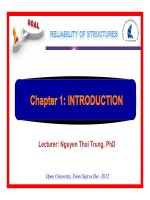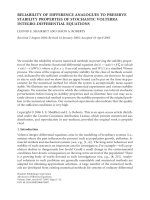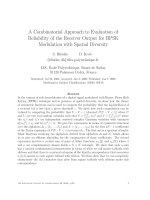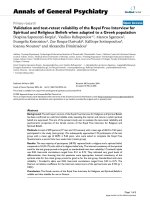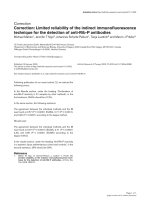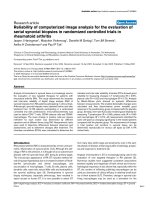Reliability of structures chapter 1
Bạn đang xem bản rút gọn của tài liệu. Xem và tải ngay bản đầy đủ của tài liệu tại đây (2.85 MB, 27 trang )
Open University, From Sept to Dec -2012
OverviewOverview
1
1
How to measure risks?How to measure risks?
2
Reliability Index and Probability of FailureReliability Index and Probability of Failure
3
Reliability Analysis ProceduresReliability Analysis Procedures
1
4
Reliability
Analysis
ProceduresReliability
Analysis
Procedures
4
ConclusionsConclusions
5
Buildings
Offices Residential structures Hospitals
H
y
draulic structures
Pi
p
elines
Brid
g
es
y
p
g
y Man-made causes
+ Design phase: approximation errors,
calculations
errors
lack
of
knowledge
y Natural causes (wind,
hurricanes, floods, tornados,
j
t
calculations
errors
,
lack
of
knowledge
+ Construction phase: use of inadequate
materials, methods of construction, bad
connections
changes
without
analysis
ma
j
o
r
s
t
orms, snow,
earthquakes, …)
connections
,
changes
without
analysis
.
+ Operation/use phase: overloading,
inadequate maintenance, misuse, vehicle
collisions
vessel
collisions
terrorist
CfUtiti
collisions
,
vessel
collisions
,
terrorist
attacks)
C
auses o
f
U
ncer
t
a
i
n
ti
es
in the building process
Uncertainties in Load and ResistanceUncertainties in Load and Resistance
(dCiC i)(dCiC i)
(L
oa
d
C
arry
i
ng
C
apac
i
ty
)(L
oa
d
C
arry
i
ng
C
apac
i
ty
)
Load & resistance parameters have to be treated as random
variables
y Occurrence probability (return period)
y Magnitude (mean values, coefficient of variation)
=> Structures must be designed to serve their function with
a probability of failure
Load and Resistance are Random Variables
y Dead load, live load, dynamic load
y Natural loads – temperature, water pressure, earth pressure, wind, snow,
th k
i
ear
th
qua
k
e,
i
ce
y Man-made causes – collisions (vehicle, vessel), fire, poor maintenance, human
errors, gas explosion, terrorist acts
y Load effects – analytical models, approximations
y Load combinations
y Material properties – concrete, steel, wood, plastics, composites
y Dimensions
Consequences of Uncertainties
y Deterministic analysis and design is insufficient
y Probability of failure is never zero
y Design codes must include a rational safety reserve (too safe – too costly,
otherwise – too many failures)
y Reliability is an efficient measure of the structural performance
Reliability and Risk Reliability and Risk
( b bili f il )( b bili f il )
(P
ro
b
a
bili
ty o
f
F
a
il
ure
)(P
ro
b
a
bili
ty o
f
F
a
il
ure
)
y Reliability = probability that the structure will perform its
function
during
the
predetermined
lifetime
function
during
the
predetermined
lifetime
y Risk (or probability of failure) = probability that the
structure will fail to perform its function during the
predetermined
lifetime
predetermined
lifetime
=> How to measure risk?=> How to measure risk?
y 50 hours = 4 hours/1 week * 12 weeks
y Evening of Thursday, from 6 PM to 9 PM
y From 13/9/2012 to 6/12/2012
y Exercises: 30% of the final result
y Presentation: 20% of the final result
y
Examination
:
50
%
of
the
final
result
y
Examination
:
50
%
of
the
final
result
y Book: Andrzej S. Nowak, Kevin Collins, “Reliability of Structures”, 2000
y Identify the load and resistance parameters (X
1
,…,X
n
)
y Formulate the limit state function, g (X
1
,…,X
n
), such that g < 0 for failure, and
g ≥ 0 for safe performance
y Calculate the risk (probability of failure, P
F
,
gRQ
=
−
P
F
=Prob(g<0)
Fundamental Case
Safety Margin, g = R – Q
what is the probability g < 0?
Probability Density Function (PDF)
Figure: PDF of load, resistance and safety margin
Fundamental case
The limit state function, g =
R
-Q,the
p
robability of failure, P
F
,can
b
ederive
d
considering the PDF’s of R and Q
Figure: PDFs of load (Q), and resistance (R)
Th
fil
h
h
ld
d
h
i
h
h
b bili
f
Fundamental case
Th
e structure
f
a
il
sw
h
en t
h
e
l
oa
d
excee
d
st
h
eres
i
stance, t
h
en t
h
e
p
ro
b
a
bili
ty o
f
failure is equal to the probability of Q>R, the following equations result
(
)
()(|)()
1
() ()
1
() ()
fii ii
fQiRiiQiRii
PPRrQr PQRRrPRr
PFr
f
rdr F r
f
rdr
+∞ +∞
==∩ >= > = =
= − = −
∑∑
∫∫
(
)
() () () ()
()(|)()
fQiRiiQiRii
fii ii
ff
P PQqRq PRQQqPQq
−∞ −∞
+∞
==∩ <= < = =
∫∫
∑∑
∫
() ()
fRiQii
PFqfqdq
−∞
=
∫
Too difficult to use, therefore, other procedures are use
d
Fundamental case
y Space of State Variables
Figure: Safe domain and failure domain in a two-dimensional state space
Fundamental case
y Space of State Variables
Figure: Three-dimensional sketch of a possible joint density function f
RQ
Reliability Index, β
ββ
Mean (RMean (R Q)Q)
Figure: PDFs of load, resistance and safety margin
Reliability Index, β
For a linear limit state function, g = R – Q = 0, and R and Q both being normal
random variables
()
22
RQ
μμ
β
−
=
22
RQ
σσ+
m
R
= mean resistance
m
Q
= mean load
s
R
= standard deviation of resistance
s
= standard deviation of load
s
Q
=
standard
deviation
of
load
Reliability Index, β
P
F
b
1010
11
1.281.28
1010
22
2.332.33
33
b b = = FF
11
(P(P
FF
) )
1010
33
3.093.09
1010
44
3.713.71
Probability of failure, P
F
1010
55
4.264.26
1010
66
4.754.75
PP
FF
= F (= F ( b)b)
1010
77
5.195.19
1010
88
5.625.62
1010
99
5.995.99
Typical values of β
y Structural components (beams, slabs, columns), b = 3-4
y
Connections:
y
Connections:
y welded b = 3-4
y bolted b = 5-7
y Structural systems (building frames, girder bridges) b = 6-8
y Closed-form equations – accurate results only for special cases
y First Order Reliability Methods (FORM), reliability index is calculated by
iterations
y Second Order Reliability Methods (SORM), and other advanced procedures
y
MtCl thd
l f d ibl i ltd( td
y
M
on
t
e
C
ar
l
o me
th
o
d
-va
l
ues o
f
ran
d
om var
i
a
bl
es are s
i
mu
l
a
t
e
d
(
genera
t
e
d
by computer), accuracy depends on the number of computer simulations
Reliability Index - Closed-Form Solution
y Let’s consider a linear limit state function
g(X
X
X
)=a
+a
X
+a
X
++a
X
g
(X
1
,
X
2
, …,
X
n
)
=
a
0
+
a
1
X
1
+
a
2
X
2
+
…
+
a
n
X
n
y X
i
= uncorrelated random variables, with unknown types of distribution, but
ihk l d d dd i i
w
i
t
h
k
nown mean va
l
ues an
d
stan
d
ar
d
d
ev
i
at
i
ons
0
i
n
iX
aaμ+
∑
0
1
2
1
()
i
i
iX
i
n
iX
i
a
β
σ
=
=
=
∑
∑
Reliability Index for a Non-linear Limit State Function
y Let’s consider a non-linear limit state function
g (X
1
, …, X
n
)
y X
i
= uncorrelated random variables, with unknown types of distribution, but with
known mean values and standard deviations
known
mean
values
and
standard
deviations
y Use a Taylor series expansion
()
()()
** *
12 1
1
, , , , ,
n
nnii
i
i
g
gX X X gx x X x
X
=
∂
≈ + −
∂
∑
where the derivatives are calculated at (X
1
*
, …, X
n
*
)
Reliability Index for a Non-linear Limit State Function
0
1
i
n
iX
i
aaμ
β
=
+
=
∑
2
1
()
i
n
iX
i
a
β
σ
=
∑
where
i
i
g
a
X
∂
=
∂
calculated at (Xcalculated at (X
11
**
, …, , …, XX
nn
**
). ).
But how to determine (XBut how to determine (X
11
**
, …, , …, XX
nn
**
)? )?
It is called the It is called the design point.point.
Monte Carlo simulations
y Given limit state function, g (X
1
,…,X
n
) and cumulative distribution function
for each random variable X
1
,…,X
n
y Generate values for variables (X
1
,…,X
n
) using computer random number
generator
generator
y For each set of generated values of (X
1
,…,X
n
) calculate value of g (X
1
,…,
X
n
), an
d
save it
Monte Carlo simulations
y Repeat this N number of times (N is usually very large, e.g. 1 million)
y Calculate probability of failure and/or reliability index
y Count the number of negative values of g, NEG,
then P
F
= NEG/N
F
y Plot the cumulative distribution function (CDF) of g on the normal
probability paper and either read the resulting value pf P
F
and b directly
from the graph, or extrapolate the lower tail of CDF, and read from the
graph.

